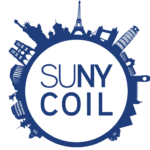COIL Standard – #4
English | Español
Teamwork Skills
 Course and project materials include activities modeling and guidance on communication styles, language usage, technological access, cultural and logistical differences when communicating with partners.
Course and project materials include activities modeling and guidance on communication styles, language usage, technological access, cultural and logistical differences when communicating with partners.
When working on a COIL partnership, the co-instructors, or instructional team need to be sensitive to any potential differences in technology access, language capabilities, time differences, and other barriers to effective communication. These considerations should be incorporated as soon as co-instructors begin to prepare the COIL course/module, and be considered as they define learner collaborations, select the tools necessary, and determine the types of activities they will need to prepare course participants for group collaborations. Developing these types of intercultural competencies that can be brought to future careers or endeavors, is one of the benefits and desired outcomes for learners in the COIL experience.
References
Barkley, E.F., Major, C.H., Cross, K.P. (2014). Collaborative Learning Techniques: A Handbook for College Faculty. (2nd ed.) San Francisco, CA: Jossey-Bass.
Deardorff, D. K. (2022). Communicating Successfully Across Differences Within COIL Virtual Exchange. In The Guide to COIL Virtual Exchange. (pp. 274–286). Stylus Pub.
de Hei, M., Tabacaru, C., Sjoer, E., Rippe, R., & Walenkamp, J. (2019). Developing Intercultural Competence Through Collaborative Learning in International Higher Education. Journal of Studies in International Education, 24(2), 190–211.
Gapinski , A. J., (2018). Assessment of effectiveness of teamwork skills learning in collaborative learning. The Journal of Management and Engineering Integration, 11(2).
Hertel, G., Konradt, U., & Voss, K. (2006). Competencies for virtual teamwork: Development and validation of a web-based selection tool for members of distributed teams . European Journal of Work and Organizational Psychology, 15(4), 477–504.
Jiménez J. L., Subbarao, S., & Bagatelia, E. (2022). An unspoken truth: faculty (in) equity in the context of invisible violence: virtual exchange case studies. Journal of Virtual Exchange, 5, 42-53.
Refresh Your Course with These Ideas
General Suggestions
- Encourage learners to work together to build team skills and collaborate equally in completing tasks and objectives for the COIL deliverables.
- Conduct a pre-collaboration meeting with your students using the checklist for a COIL Project Introduction to establish what COIL is; what to expect in the intercultural collaboration; what the cultural / historic / geo-political differences in countries of the collaboration will be; and to explain the benefits of participating in a COIL experience.
- Provide expanded online learning netiquette information to include a section on cultural awareness. Example: Practicing Inclusive Communication in Your Courses.
Cross-Cultural Considerations
COIL can be a valuable addition to the AIDE (Access, Inclusion, Diversity, and Equity) toolbox, particularly at higher education institutions in socio-economically privileged countries. Traditional power structures and invisible privileges can easily negatively impact a COIL experience, particularly when faculty from socio-economically privileged cultures are not fully cognizant of the sociopolitical realities being experienced by their partners in socio-economically challenged regions. Solutions should go beyond practicing cultural humility. COIL is intended to be grounded in the ethical responsibility of honoring the human capital that both partners bring to the partnership, (Jimenez et. al, 2022).
Explore Related Materials
- Crossing Borders Education. (2016, October 12). Conflict Mediation Toolkit. From Film Clips Overview: Intercultural Film Clips. Based on the Crossing Borders Films Trilogy.
- SUNY COIL Student Orientation https://sunyolis.libguides.com/sunycoil/start
Share What You Know
The COIL Standards have been developed by a community of COIL online practitioners interested in quality online course design and international virtual experiences. There are numerous opportunities for community members to offer suggestions, donate resources, and help with future development.
Discuss this standard in the comments section at the bottom of this page.
Contribute your own ideas or refresh resources by filling out the COIL Examples Contribution Form.